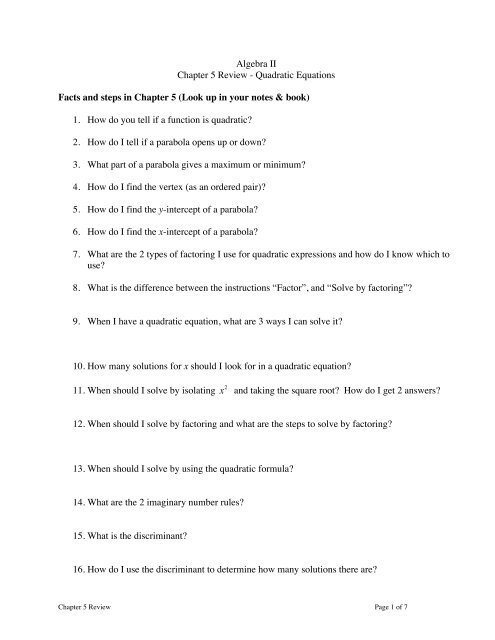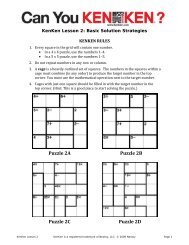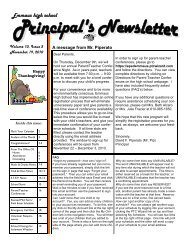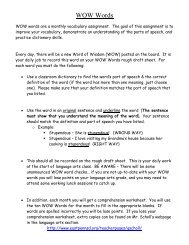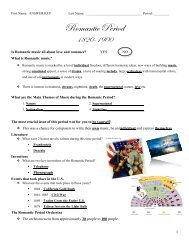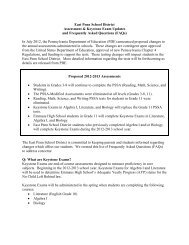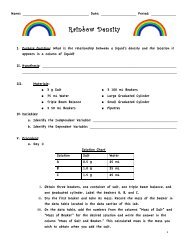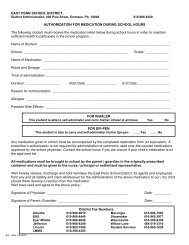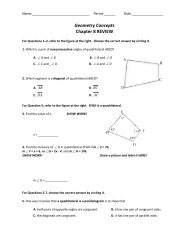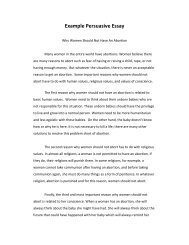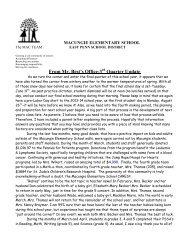Algebra II Chapter 5 Review - Quadratic Equations Facts and steps ...
Algebra II Chapter 5 Review - Quadratic Equations Facts and steps ...
Algebra II Chapter 5 Review - Quadratic Equations Facts and steps ...
Create successful ePaper yourself
Turn your PDF publications into a flip-book with our unique Google optimized e-Paper software.
<strong>Algebra</strong> <strong>II</strong><br />
<strong>Chapter</strong> 5 <strong>Review</strong> - <strong>Quadratic</strong> <strong>Equations</strong><br />
<strong>Facts</strong> <strong>and</strong> <strong>steps</strong> in <strong>Chapter</strong> 5 (Look up in your notes & book)<br />
1. How do you tell if a function is quadratic?<br />
2. How do I tell if a parabola opens up or down?<br />
3. What part of a parabola gives a maximum or minimum?<br />
4. How do I find the vertex (as an ordered pair)?<br />
5. How do I find the y-intercept of a parabola?<br />
6. How do I find the x-intercept of a parabola?<br />
7. What are the 2 types of factoring I use for quadratic expressions <strong>and</strong> how do I know which to<br />
use?<br />
8. What is the difference between the instructions “Factor”, <strong>and</strong> “Solve by factoring”?<br />
9. When I have a quadratic equation, what are 3 ways I can solve it?<br />
10. How many solutions for x should I look for in a quadratic equation?<br />
11. When should I solve by isolating <strong>and</strong> taking the square root? How do I get 2 answers?<br />
12. When should I solve by factoring <strong>and</strong> what are the <strong>steps</strong> to solve by factoring?<br />
13. When should I solve by using the quadratic formula?<br />
14. What are the 2 imaginary number rules?<br />
15. What is the discriminant?<br />
16. How do I use the discriminant to determine how many solutions there are?<br />
<strong>Chapter</strong> 5 <strong>Review</strong> Page 1 of 7
<strong>Review</strong> Problems<br />
Simplify <strong>and</strong> determine whether each function is linear or quadratic.<br />
1. 2.<br />
Identify the vertex, the axis of symmetry, <strong>and</strong> maximum or minimum values.<br />
3. 4.<br />
5. A model for a company’s revenue is , where p is the price in dollars<br />
of the company’s product. What price will maximize revenue? Find the maximum revenue. Explain.<br />
6. The equation for the motion of a projectile fired straight up in the air is , where<br />
f(t) is height in feet <strong>and</strong> t is the time in seconds. Find the time the projectile needs to reach its highest<br />
point. How high will it go?<br />
<strong>Chapter</strong> 5 <strong>Review</strong> Page 2 of 7
7. The equation for the cost in dollars of producing automobile tires is ,<br />
where x is the number of tires produced. Find the number of tires that minimizes the cost. What is<br />
the cost for that number of tires? Explain your method.<br />
8. In a circus act, a performer is shot out of a cannon. The height, in feet, he travels is given by the<br />
function<br />
, where t is the time in seconds. Find the vertex.<br />
A. What is the maximum height reached by the circus performer?<br />
B. At what time, t, does he reach the maximum height?<br />
Graph 9,10 by finding the vertex <strong>and</strong> 2 other points.<br />
9. 10.<br />
Identify the vertex of the graph of each function, <strong>and</strong> whether it opens up or down.<br />
11. 12.<br />
<strong>Chapter</strong> 5 <strong>Review</strong> Page 3 of 7
Factor each of the following completely.<br />
13. 14.<br />
15. 16.<br />
17. 18.<br />
Solve each equation by factoring or taking square roots.<br />
19. 20.<br />
21. 22.<br />
23. 24.<br />
<strong>Chapter</strong> 5 <strong>Review</strong> Page 4 of 7
Simplify each expression.<br />
25. 26.<br />
27. 28.<br />
29. 30.<br />
31. 32.<br />
Find the discriminant (<br />
). Select the number <strong>and</strong> type of solutions.<br />
33. Discriminant: ____________________<br />
_____2 real solutions ______no real solutions (2 imaginary) ______1 real solution<br />
34. Discriminant: ____________________<br />
_____2 real solutions ______no real solutions (2 imaginary) ______1 real solution<br />
35. Discriminant: ____________________<br />
_____2 real solutions ______no real solutions (2 imaginary) ______1 real solution<br />
<strong>Chapter</strong> 5 <strong>Review</strong> Page 5 of 7
Solve each equation by using the <strong>Quadratic</strong> Formula.<br />
36.<br />
37.<br />
38.<br />
<strong>Chapter</strong> 5 <strong>Review</strong> Page 6 of 7
39. A field hockey player hits the ball into the air when it is four feet off the ground. Its<br />
initial velocity is 90 feet per second. After it is hit for a specific amount of time, t (in<br />
seconds), the height h (in feet) of the ball can be modeled by the quadratic equation:<br />
h(t) = −16t 2 + 90t + 4<br />
a. When did the ball hit the ground in the field if no players interceded its path<br />
€<br />
b. When did the ball hit another player’s stick if that player’s stick is 3 feet in the air?<br />
c. How much time has elapsed when the ball reaches the maximum height?<br />
d. How high did the ball reach at the maximum height?<br />
40. The recommended dosage of a certain type of medicine is determined by the patient’s body<br />
weight. The formula to determine the dosage is<br />
, where D is the dosage in<br />
milligrams (mg) <strong>and</strong> w is the patient’s body weight in kilograms. What is the maximum<br />
weight of a patient that you can treat with 1800 mg of this medicine?<br />
<strong>Chapter</strong> 5 <strong>Review</strong> Page 7 of 7


